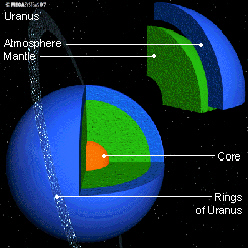|
|
|
URANUS
Uranus / Introduction
The distance between Uranus and the sun is approximately double the distance
from the sun to Saturn. The planet was discovered in 1781 by Herschel and is
the seventh planet in the Solar System. Due to its immense distance from the
sun, only a very small part of the sun’s light ever reaches the planet.
Therefore, Uranus is a very cold world with temperatures of around minus
215°C.
 The
composition and structureof Uranus is very similar to that of Jupiter and
Saturn. Its atmosphere consists mainly ofhydrogen (83%), mixed with small
amounts of helium (15%) and methane (2%). The methane gas gives the planet
its slightly greenish-blue color. The
composition and structureof Uranus is very similar to that of Jupiter and
Saturn. Its atmosphere consists mainly ofhydrogen (83%), mixed with small
amounts of helium (15%) and methane (2%). The methane gas gives the planet
its slightly greenish-blue color.
Up to the mid-1980s, only five moons were known. The spacecraft Voyager 2
subsequently discovered ten more satellites that are however considerably
smaller.The moons were named after characters in plays by William
Shakespeare. Of special interest is the unusual inclination of the axis of
Uranus, which is nearly parallel to its orbit plane. Therefore, the south
and the north pole of the planet face the sun alternatively.
Orbit of Uranus
Uranus revolves once around the sun every 84 years (= 1 Uranus year). It
completes one rotation on its own axis in a period of 17 hours and 15
minutes (= 1 Uranus day). Its mean distance from the sun is 2.88 billion
kilometers.
 Uranus
moves on its orbit at a velocity of 6.81 kilometers persecond. A unique
characteristic of the planet is the pronounce dinclination of its rotation
axis towards the orbit plane. Uranus
moves on its orbit at a velocity of 6.81 kilometers persecond. A unique
characteristic of the planet is the pronounce dinclination of its rotation
axis towards the orbit plane.
The inclination of 98 degrees is much more prominent than that ofother
planets (e.g. earth23.5 degrees). The planet therefore ”lies“ on its orbit
plane and its northand south pole are temporarily directly facing the sun.
Therefore, winter on the northern hemisphere of the planet lasts for 42
years and the summers are equally long. Due to the vast distance of the
planet from the sun, the difference in temperature between summer and winter
is only 2 °C.
The ring system of Uranus consists of ill-defined dust belts. The fifteen so
far known moons revolve around Uranus in independent orbits partly inside
and partly outside the ring system.
Composition of Uranus
The equatorial diameter of Uranus is approximately 51,000 kilometers and
only slightly larger than the distance from pole to pole. The average
density of the planet is equal to 1.3 times that of water. Uranus has
therefore a density of between those of Saturn and Jupiter. This implies
that Uranus must contain greater amounts of heavier metals.
 Uranus
is very similar in structure to Saturn. The are though a few distinct
differences. The core of Uranus consists of rocky materialat a temperature
of approximately 7000 °C. This core is surrounded by a layer of water mixed
with methane and ammonia. Uranus
is very similar in structure to Saturn. The are though a few distinct
differences. The core of Uranus consists of rocky materialat a temperature
of approximately 7000 °C. This core is surrounded by a layer of water mixed
with methane and ammonia.
Adjacent to this layer there is an atmosphere of hydrogen, helium and
methane.One of the characteristics of methane gas is it absorption of red
light. Therefore, Uranus appears to us a bluish-green disk.Temperatures in
the different locations of Uranus vary. The parts facing the sun during the
year are slightly warmer than the equatorial zone, which is rarely exposed
to sunlight. Near the equator there are strong winds with velocities of up
to 1000 kilometers per hour.
The surface of Uranus is a rather featureless desert. Only a few thin cloud
bands were observed by the Voyager 2 spacecraft during its exploratory
passage in 1986. Astonishingly, these clouds do not move in the direction
which would be the most obvious one, namely from the north to the south
pole, following the plane of the orbit. They actually move around the
equatorial plane. Uranus Moons
Uranus has 15 satellites and aring system. The larger five moons have been
known for many years while the other ten moons have only beendiscovered in
1986 by theVoyager 2 spacecraft. The moonsand rings of Uranus orbit the
planet in a plane through its equator.
 Titania
and Oberon are the brightest satellites and were discoveredin 1787 by W.
Herschel. The discovery of Ariel and Umbriel followed in the mid-18th
century and in 1948, Miranda was first detected. Titania
and Oberon are the brightest satellites and were discoveredin 1787 by W.
Herschel. The discovery of Ariel and Umbriel followed in the mid-18th
century and in 1948, Miranda was first detected.
The first five discovered moons of Uranus are the ones most distant from the
planet, i.e. its outer moons. Oberon for example is 580,000 kilometers from
Uranus. Its neighbor Titania has a diameter of 1580 kilometers and is the
largest moon of Uranus. It consists of rock and ice and its surface features
a system of valleys. Umbriel has a much darker surface. Its inner neighbors
are Ariel and Miranda, which is the smallest of the outer planets.
The small moons of Uranus are Puck, Belinda, Rosalind, Portia, Julia,
Desdemona, Cressida, Bianca, Ophelia and Cordelia. They are all named after
famous characters in plays by William Shakespeare.
Ophelia and Cordelia are shepherd moons. Cordelia’s orbit is inside the ring
system. These small satellites are nothing more than large blocks of rock
and ice with diameters of less than 150 kilometers. Their mass is not
sufficient to form matter into the spherical shape typical of most moons in
the Solar System.
©by megasystems
|
|
|